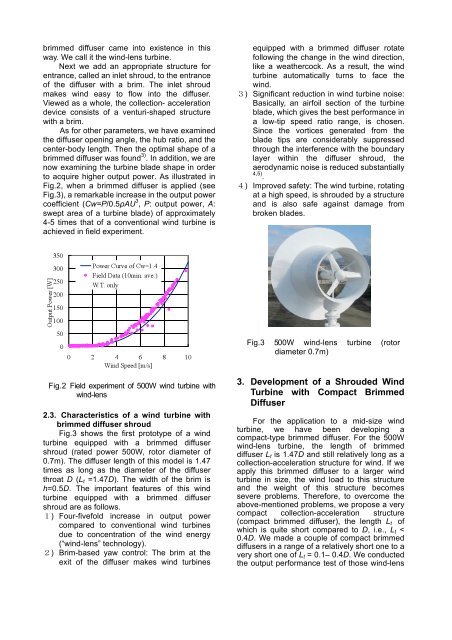A SHROUDED WIND TURBINE GENERATING HIGH OUTPUT ...
A SHROUDED WIND TURBINE GENERATING HIGH OUTPUT ...
A SHROUDED WIND TURBINE GENERATING HIGH OUTPUT ...
Create successful ePaper yourself
Turn your PDF publications into a flip-book with our unique Google optimized e-Paper software.
immed diffuser came into existence in this<br />
way. We call it the wind-lens turbine.<br />
Next we add an appropriate structure for<br />
entrance, called an inlet shroud, to the entrance<br />
of the diffuser with a brim. The inlet shroud<br />
makes wind easy to flow into the diffuser.<br />
Viewed as a whole, the collection- acceleration<br />
device consists of a venturi-shaped structure<br />
with a brim.<br />
As for other parameters, we have examined<br />
the diffuser opening angle, the hub ratio, and the<br />
center-body length. Then the optimal shape of a<br />
brimmed diffuser was found 3) . In addition, we are<br />
now examining the turbine blade shape in order<br />
to acquire higher output power. As illustrated in<br />
Fig.2, when a brimmed diffuser is applied (see<br />
Fig.3), a remarkable increase in the output power<br />
coefficient (Cw=P/0.5ρAU 3 , P: output power, A:<br />
swept area of a turbine blade) of approximately<br />
4-5 times that of a conventional wind turbine is<br />
achieved in field experiment.<br />
equipped with a brimmed diffuser rotate<br />
following the change in the wind direction,<br />
like a weathercock. As a result, the wind<br />
turbine automatically turns to face the<br />
wind.<br />
) Significant reduction in wind turbine noise:<br />
Basically, an airfoil section of the turbine<br />
blade, which gives the best performance in<br />
a low-tip speed ratio range, is chosen.<br />
Since the vortices generated from the<br />
blade tips are considerably suppressed<br />
through the interference with the boundary<br />
layer within the diffuser shroud, the<br />
aerodynamic noise is reduced substantially<br />
4,5) .<br />
) Improved safety: The wind turbine, rotating<br />
at a high speed, is shrouded by a structure<br />
and is also safe against damage from<br />
broken blades.<br />
Fig.3 500W wind-lens turbine (rotor<br />
diameter 0.7m)<br />
Fig.2 Field experiment of 500W wind turbine with<br />
wind-lens<br />
2.3. Characteristics of a wind turbine with<br />
brimmed diffuser shroud<br />
Fig.3 shows the first prototype of a wind<br />
turbine equipped with a brimmed diffuser<br />
shroud (rated power 500W, rotor diameter of<br />
0.7m). The diffuser length of this model is 1.47<br />
times as long as the diameter of the diffuser<br />
throat D (L t =1.47D). The width of the brim is<br />
h=0.5D. The important features of this wind<br />
turbine equipped with a brimmed diffuser<br />
shroud are as follows.<br />
) Four-fivefold increase in output power<br />
compared to conventional wind turbines<br />
due to concentration of the wind energy<br />
(“wind-lens” technology).<br />
) Brim-based yaw control: The brim at the<br />
exit of the diffuser makes wind turbines<br />
3. Development of a Shrouded Wind<br />
Turbine with Compact Brimmed<br />
Diffuser<br />
For the application to a mid-size wind<br />
turbine, we have been developing a<br />
compact-type brimmed diffuser. For the 500W<br />
wind-lens turbine, the length of brimmed<br />
diffuser L t is 1.47D and still relatively long as a<br />
collection-acceleration structure for wind. If we<br />
apply this brimmed diffuser to a larger wind<br />
turbine in size, the wind load to this structure<br />
and the weight of this structure becomes<br />
severe problems. Therefore, to overcome the<br />
above-mentioned problems, we propose a very<br />
compact collection-acceleration structure<br />
(compact brimmed diffuser), the length L t of<br />
which is quite short compared to D, i.e., L t <<br />
0.4D. We made a couple of compact brimmed<br />
diffusers in a range of a relatively short one to a<br />
very short one of L t = 0.1– 0.4D. We conducted<br />
the output performance test of those wind-lens
















